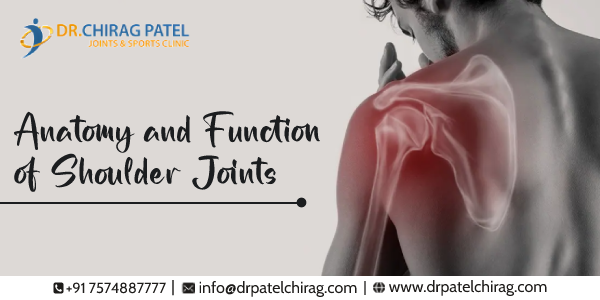Shoulder Joint : The shoulder is the most mobile and at the same time most unstable joint in the human body. Owing to its complex structure it offers the highest range of motion over another joint. And this also makes it highly vulnerable to injury in sports or even in daily life.
At our joints and sports clinic in Mumbai, we often get consulted by patients with shoulder strains and injuries. This most often happens due to a lack of right information about the joint and the care that must be taken for a healthy shoulder. So in this blog today, with the input of the best shoulder surgeon in Mumbai Dr Chirag Patel we shed light on the function and anatomy of the shoulder joint to improve your awareness. Read on:
The Function of Shoulder Joint:
From mobility activities like walking, throwing, and running to daily activities like reaching an item on the shelf – there isn’t any upper body functional movement where the shoulder doesn’t play a crucial role. The function of the shoulder joint is to hold the shoulder bones in place to enable movement of the arms – upward, downward, forward and backwards.
Anatomy of Shoulder Joint:
The shoulder is a ball and socket joint that is primarily formed by three bones – humerus (upper arm bone), scapula (shoulder blade) and clavicle (collar bone). The head of the humerus bone forms a ball-type structure that is lined with cartilage and sits in the socket, called the glenoid cavity with support from muscles, tendons and ligaments. Thus enabling the shoulder joint to perform extension, flexion, abduction, adduction, internal rotation, external rotation and circumduction.
“This support system of muscles, tendons and ligaments are collectively called rotator cuff and they ensure free movement of the joint by keeping the ball and socket in place”, says the best orthopaedic surgeon in Mumbai Dr Chirag Patel.
The injury to any of these components will result in a myriad of problems and the most common ones are:
Adhesive capsulitis:
Frozen shoulder that results in pain, spasm and stiffness. Frozen shoulder treatment in Mumbai is commonly performed to treat this condition.
Bursitis:
Inflammation of bursae – the fluid-filled sacs in the shoulder.
Rotator Cuff Injury:
Injury to the support system – ligaments, tendons or muscles usually due to sports and injuries.
Shoulder Impingement Syndrome:
Inflammation of soft tissue when the bones rub on each other. Often occurs in swimmers.
How to prevent Shoulder Injuries?
Whether you are an athlete or a regular individual it is important to keep the joint hale and healthy. Given its tendency to get injured often, a consistent physical training regimen is considered paramount. Exercises that improve mobility, and increase range of motion and strength must be carefully incorporated into a daily routine to guard the shoulder against the injuries. If you are in Mumbai and are looking to improve your shoulder health to prevent potential injuries, then Dr Chirag Patel is the best shoulder specialist in Mumbai who can help you.
As a shoulder surgeon who has helped hundreds of sportsmen and the elderly retain their shoulder function, Dr Chirag Patel can treat your shoulder issues and help you prevent potential shoulder problems. You can contact him here: https://www.drpatelchirag.com/





